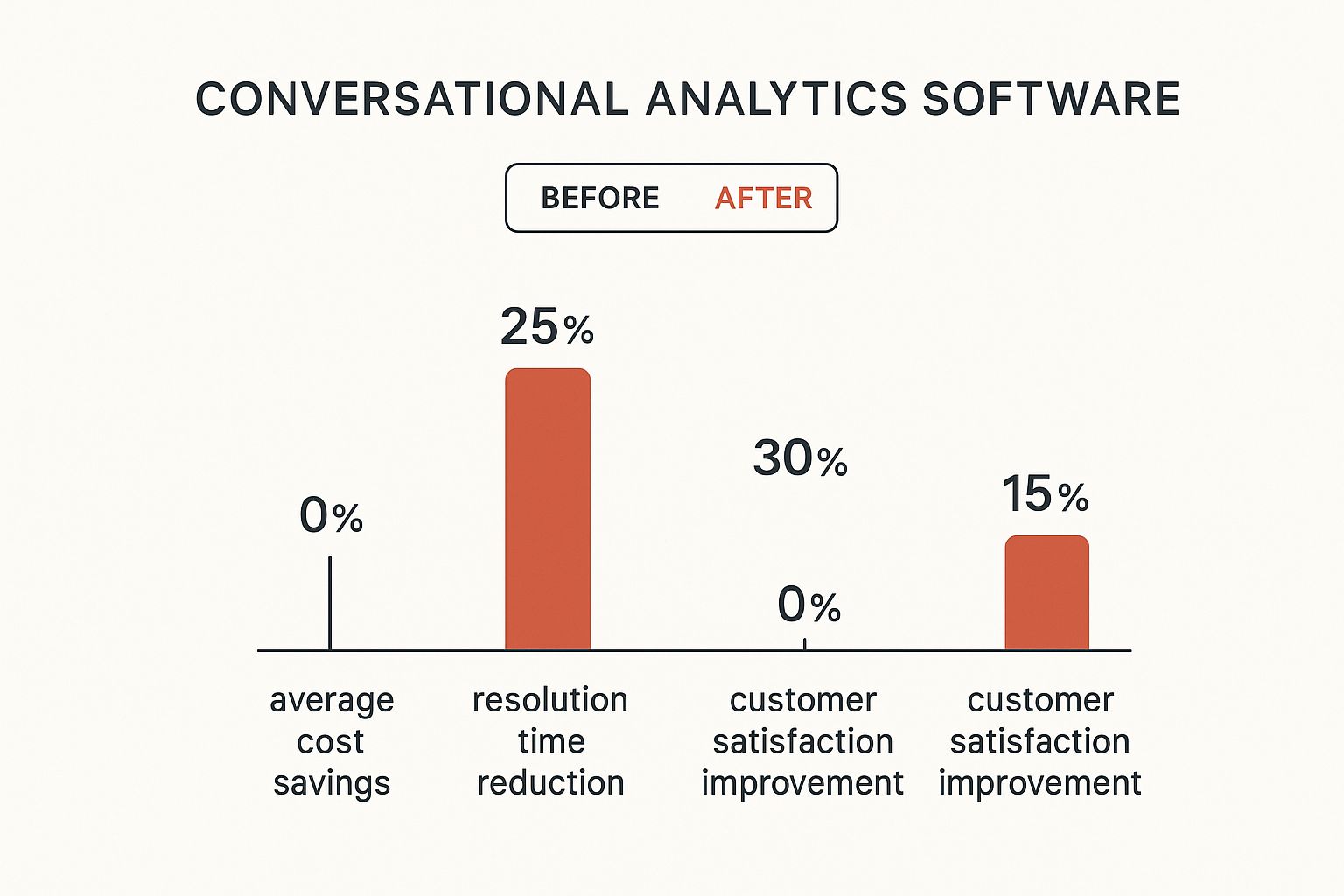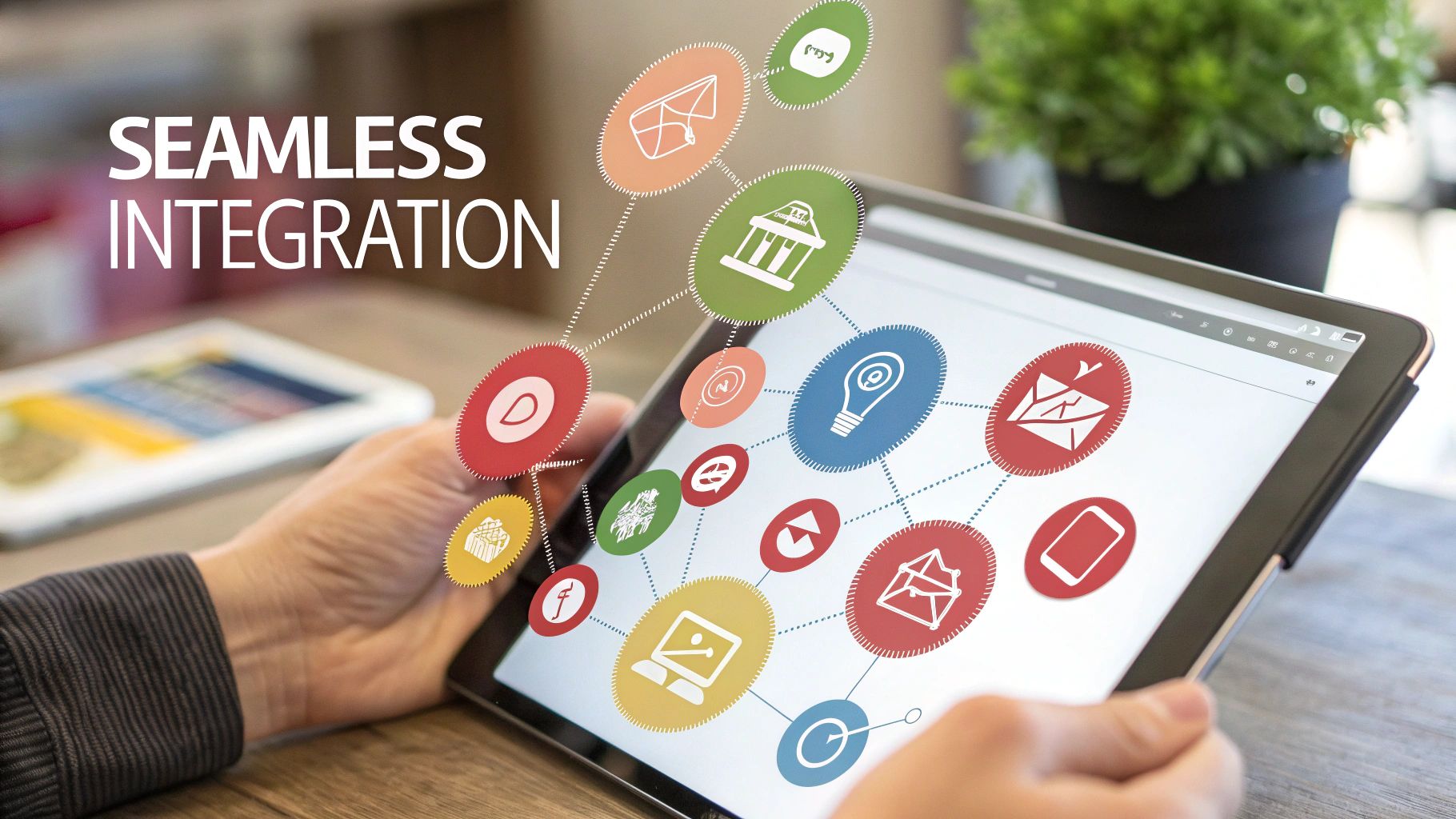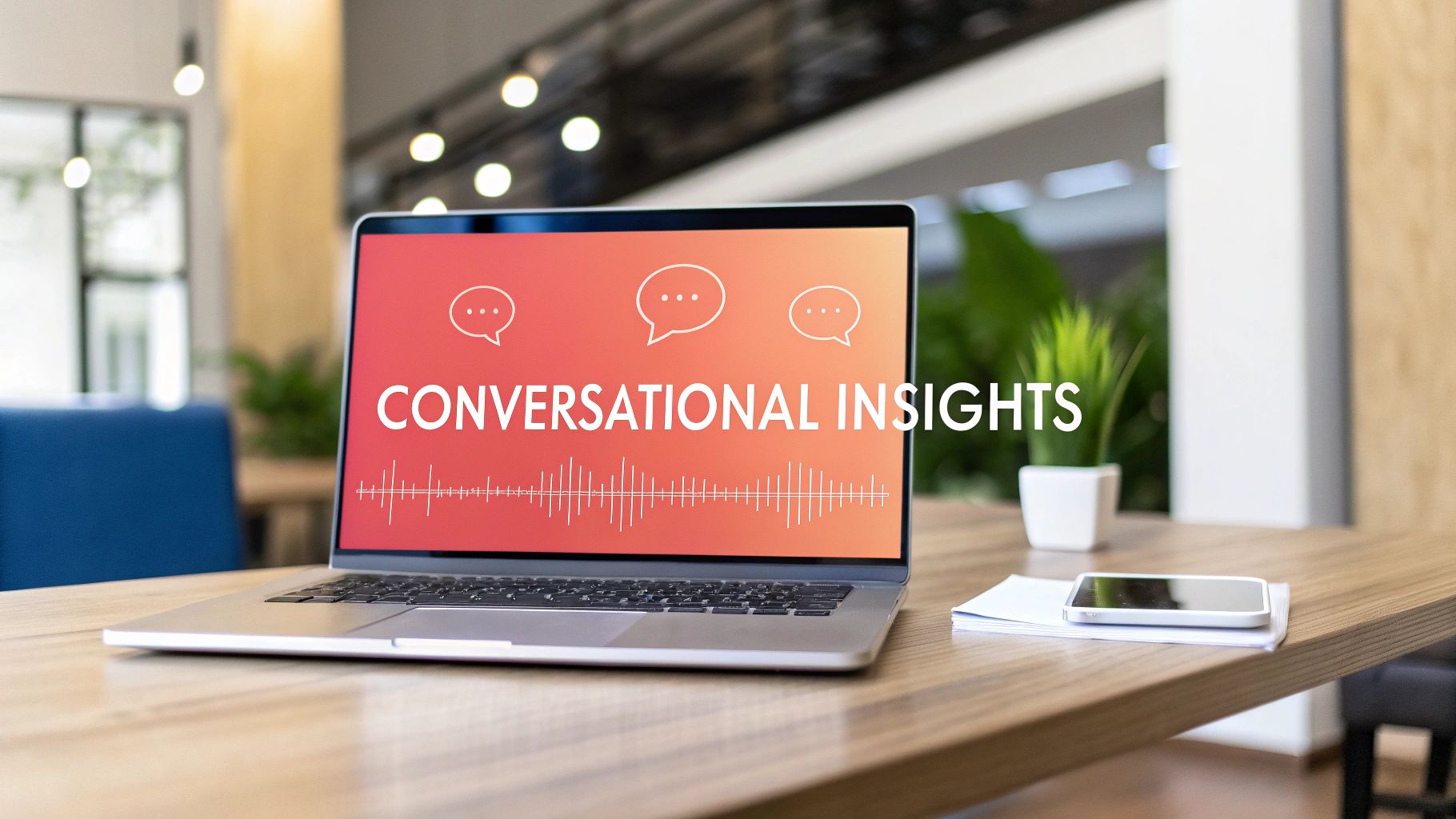Conversational analytics software is a game-changer for agencies. In simple terms, it's a tool that records and analyzes client and customer conversations from calls, chats, and meetings to dig up incredibly valuable, actionable insights.
Think of it this way: instead of just reporting on vanity metrics like clicks and impressions, your agency can finally prove the real-world value of your campaigns. The software takes all that messy, unstructured voice and text data and turns it into structured intelligence, showing you exactly what makes leads convert and clients stick around.
Moving Beyond Clicks to Prove Your Agency's True Value
As an agency, you’re under constant pressure to show clients clear, undeniable ROI. It’s a relentless cycle. You build brilliant campaigns, you drive a ton of traffic, and you generate leads, but at the end of the day, clients always come back to one question: "How is this making me money?"
Your standard reports, packed with metrics like clicks, impressions, and open rates, only paint half the picture. They show activity, sure, but they completely miss the crucial context of why a lead decided to buy or what a customer actually needs.
This is where many agencies are basically flying blind. It's like being a pilot with only half your instruments working. You can see your altitude and speed (your clicks and traffic), but you have zero visibility into the weather ahead or the terrain below—the actual conversations happening with your client's leads. Without that data, you're making strategic decisions based on guesswork, leaving money on the table and creating a perfect opportunity for client churn.
Why Surface-Level Reporting Fails Your Agency and Your Clients
The classic agency report just doesn't cut it anymore because it has no depth. It might show that your latest campaign generated 100 phone calls, which sounds great. But it can't answer the questions that really matter to your clients:
- Lead Quality: How many of those 100 callers were legitimate, qualified prospects? How many were just customer support questions or spam calls?
- Campaign Effectiveness: Which specific ad, keyword, or landing page sparked the most valuable conversations?
- Customer Pain Points: What common questions or objections kept popping up on those calls? This is gold for refining future marketing messages.
Without those answers, you're left to make assumptions. You might pour more budget into a campaign that drives a high volume of calls, only to find out later they were all low-quality leads. That’s a waste of your client's money and your team's time. This is exactly where conversational analytics software becomes your agency's secret weapon.
This technology is like a flight recorder for your client's business, capturing and analyzing every critical detail of every interaction. It transforms messy, unstructured dialogue into a goldmine of strategic insights that prove your agency's true impact.
Instead of just showing your clients a spreadsheet of numbers, you can walk in with concrete proof. Imagine being able to say, "Not only did this landing page drive calls, but the people calling specifically mentioned the '20% off promotion,' and those calls had a 70% conversion rate."
That's the kind of detail that directly connects your marketing efforts to your client's revenue. It builds unshakable trust and locks in those long-term partnerships. It’s no longer just another tool in your stack; it's the key to proving your undeniable value.
What Is Conversational Analytics Software and Why Should Agencies Care?

Let's cut through the jargon. Think of conversational analytics software as an expert translator for your agency. But instead of turning Spanish into English, it turns messy, unstructured human dialogue into pure business strategy. At its heart, this software uses a powerful mix of artificial intelligence (AI), Natural Language Processing (NLP), and machine learning to make sense of every single call, meeting, and chat your agency handles for its clients.
This goes way beyond basic call tracking. Knowing that a lead called is one thing; knowing why that call was a home run—or a total flop—is something else entirely. That's the gap this technology fills. The market for this tech was valued at roughly USD 1.27 billion and is expected to explode to USD 3.55 billion by 2033. For agencies, this growth signals a major shift in how client value is measured.
This software automatically transcribes what’s said, then dives deep into the text to analyze sentiment, keywords, topics, and even unspoken customer intent. It’s the difference between having a simple logbook of phone numbers and possessing a detailed playbook of what truly makes your client's customers tick. You can explore a deeper explanation of this concept in our guide on conversation intelligence.
How Raw Client Dialogue Is Transformed Into Actionable Data
For an agency, this process is a game-changer. It turns what was once just "talk" into a rich source of strategic intelligence. It systematically captures, processes, and structures these conversations to reveal patterns that are completely invisible to the human ear alone.
Here’s a quick look at how it works under the hood:
- Recording and Transcribing: First, it captures the audio from calls or meetings and converts it into surprisingly accurate, searchable text.
- Analyzing with NLP: This is the real magic. The NLP "brain" dissects the transcript to understand context, identify key phrases (like competitor names or specific product features), and even gauge the emotional tone of each speaker.
- Structuring the Insights: Finally, it organizes all this analyzed data into clean dashboards and reports. This is where your agency can spot trends, pinpoint which sales pitches are actually working, and flag recurring customer pain points.
Bottom line? You can finally prove which marketing messages are resonating in real-world sales calls, not just in theory. It connects the dots from your campaigns all the way to revenue. For context, this is similar to how tools like email analytics provide deep insights into client communication, but applied to spoken conversations.
Gaining a Holistic View Across All Client Communication Channels
And don't just think phone calls. Modern conversational analytics software casts a wide net, giving your agency a complete picture of client interactions across tons of different touchpoints. This holistic view is crucial for understanding the entire customer journey and optimizing your strategy from top to bottom.
Think of it this way: Your agency is already sitting on a goldmine of data locked away in conversations. This software is the key that unlocks it, turning raw dialogue into a measurable asset that demonstrates your value and drives real client growth.
To give you a clearer idea of just how broad this technology's reach is, the table below breaks down the variety of interactions these platforms can analyze.
Types of Interactions Analyzed and Their Value to Agencies
This table illustrates the range of client and customer conversations that modern analytics software can capture and analyze, providing agencies with a holistic view of the communication landscape.
As you can see, the applications for your agency are vast. By plugging into these different channels, you're not just getting a slice of the pie—you're getting the entire picture of how customers interact with your client's brand.
Platform Features That Directly Impact Agency Success

When your agency is shopping for conversational analytics software, it’s easy to get lost in a sea of technical jargon and endless feature lists. For an agency, though, the best features are the ones that solve your real, everyday headaches—the ones that save time, prove your value, and make client relationships stronger.
Let's ditch the generic checklist. Instead, we'll look at these features based on the agency problems they actually solve. This way, you can see exactly how the tech connects to your team's daily grind and your agency's bottom line.
Feature #1: Automate Administrative Tasks to Free Up Billable Time
Agency life is a constant battle against the clock. Your account managers and project leads are often drowning in manual note-taking and administrative follow-up, pulling them away from the high-value strategic work clients pay for. Conversational analytics tools attack this problem head-on.
The absolute cornerstone here is AI-Powered Transcription and Summarization. Picture this: your account manager wraps up a 60-minute client strategy call. Instead of spending the next half-hour trying to decipher scribbled notes and type up a coherent summary, the software delivers a near-perfect transcript and a sharp, AI-generated summary of key decisions and action items in minutes.
This isn't just about saving a few minutes here and there. It's about fundamentally reallocating that time to what truly matters—digging into campaign performance, brainstorming new creative, and actually nurturing the client relationship. The software handles the "what was said" so your team can focus on "what we do next."
By automating the documentation of every client interaction, your agency creates a single source of truth. This eliminates disputes over scope creep and ensures everyone—from the project manager to the creative team—is aligned on client expectations.
Feature #2: Pinpoint Winning Messages to Optimize Client Campaigns
How do you know which of your marketing messages really land with customers? Sure, you can A/B test a landing page, but understanding the exact phrases that make a prospect's ears perk up during a sales call? That’s a whole different level of insight.
This is where Keyword and Topic Spotting becomes your agency's secret weapon. The software automatically scans every conversation for predefined words and phrases—think competitor names, product features, or specific promo codes. You get an instant, unfiltered look at which campaigns are actually driving conversations about the topics you care about.
Let’s say your agency runs two ad campaigns for a client: one hammering "affordability" and the other highlighting "premium quality." With keyword spotting, you can track which term is mentioned more often in sales calls that lead to a closed deal. This gives you hard evidence to double down on the winning message and make your client's ad spend work harder.
Feature #3: Analyze Sentiment to Gauge Lead Quality and Client Health
A high volume of calls means nothing if they're all from unqualified leads or unhappy customers. Your agency needs a way to prove that your campaigns are delivering truly qualified, high-intent prospects who are ready to pull the trigger.
Sentiment Analysis is the feature that makes this possible. The software analyzes the tone, word choice, and emotion in a conversation to assign a sentiment score—positive, neutral, or negative. This lets you instantly tell the difference between a genuinely excited lead and a frustrated customer with a support issue. By exploring this topic further, you can discover all about what customer sentiment analysis is and how to apply it effectively.
This feature also works as an early warning system for your own client relationships. A noticeable dip in sentiment during your weekly check-in calls can flag a problem before it escalates, giving your team a chance to step in, address their concerns, and protect your agency's reputation and revenue.
Finally, Performance Dashboards and Reporting tie everything together. These visual tools compile all the data—from keyword mentions to sentiment trends—into clean, compelling reports. You can finally stop showing clients clunky spreadsheets and start telling clear, data-backed stories that prove the superior quality of the leads you generate, locking in your agency’s indispensable value.
How Conversational Analytics Transforms Your Agency's Operations
Let's move beyond a simple feature list. The real magic of conversational analytics software is how it fundamentally rewires the way your agency operates. It’s not just about what the tool does, but about the tangible results it creates—results that directly boost your efficiency, profitability, and client retention.
Think of this technology as a force multiplier for your agency. It takes all that invisible conversation data and turns it into your most valuable strategic asset. You can finally stop just executing campaigns and start proving their direct impact on your client's bottom line.
From Reactive Service Provider to Proactive Strategic Partner
Most agencies operate in a reactive mode, waiting for clients to tell them what they need next. This approach leaves a ton of revenue on the table simply because you don't know what you don't know.
Imagine this before-and-after. An account manager might completely miss a client's offhand comment in a meeting about "struggling with lead follow-up." But after implementation, the software flags "lead follow-up" and "CRM issues" as recurring topics. Suddenly, you have a data-backed reason to propose a new CRM integration project or a lead nurturing campaign.
This is how your agency shifts from being a service provider to a strategic partner. You're not waiting for clients to diagnose their own problems; you're proactively identifying their pain points in their own words, making your agency indispensable.
Connecting Marketing Spend to Revenue with Concrete Proof
One of the oldest agency headaches is connecting marketing spend to real results. Clicks and impressions are fine, but proving that a specific campaign generated high-quality leads that actually closed? That's always been the hard part.
Conversational analytics is the bridge. By tracking which keywords, ad copy, and campaign themes are mentioned in successful sales calls, you can draw a straight line from your work to a closed deal. You can confidently report, "Our 'premium quality' ad campaign led to 30% more conversations about top-tier products, and those calls had a 65% higher closing rate."
This is a level of detail you just can't get from traditional analytics. It changes the entire client conversation from justifying costs to celebrating undeniable ROI.
This infographic gives you a clear picture of the kind of operational gains agencies can expect after bringing these tools on board.

As you can see, the data doesn't lie. Implementing these tools drives significant, measurable improvements across the metrics that matter most to your clients and your agency.
Enhancing Team Training and Streamlining Client Reporting
Getting junior staff up to speed is a slow, often abstract process. With conversational analytics, your agency can build a library of "greatest hits" call recordings. A new account manager can listen to exactly how a senior team member masterfully handles a tough client objection or smoothly pitches an upsell.
This kind of practical, real-world training is invaluable. It drastically shortens the learning curve and ensures everyone on your team delivers a consistent, high-quality experience. The insights gathered are also central to effective call center optimization strategies, a huge value-add for agencies that manage client support teams.
Client reporting also gets a massive upgrade. The software can automatically generate summaries, pinpoint key moments, and pull relevant stats, turning what used to be a half-day chore into a quick 30-minute review. This is similar to the efficiency gains agencies see when using AI for their own internal processes, like with AI for meeting minutes.
This automation doesn't just save hundreds of agency hours every year; it elevates the strategic quality of your client reports. The growth in this market is hard to ignore; the conversational AI space is projected to explode from USD 12.82 billion to a staggering USD 136.41 billion by 2035.
Strategic Advantages for Every Agency Department
To really grasp the impact, it helps to see how this software transforms the day-to-day realities of different teams within your agency. It's not a single-department tool; it's an operational upgrade for the entire organization.
The table below breaks down the common pain points and the powerful solutions conversational analytics delivers.
As you can see, the benefits cascade across the agency. What starts as a simple tool for call analysis quickly becomes a central nervous system for client intelligence, empowering every department to work smarter and deliver better results.
How to Choose the Right Platform for Your Agency's Needs

Picking the right conversational analytics software isn't about grabbing the one with the longest feature list. For an agency, the best platform is the one that slots right into your workflow, makes your client reporting shine, and grows with you. It should empower your team, not create more busywork.
Make the wrong call, and you're in for a world of headaches. You could end up battling a tool that's way too complex or, even worse, finding out it's missing a critical integration after you’ve signed on the dotted line. A little due diligence upfront helps your agency find a true strategic asset.
These tools are quickly becoming table stakes. A huge percentage of white-collar workers now interact with conversational AI regularly, a trend that only picked up steam with the shift to remote work. You can get more insights on how conversational AI is becoming a business staple over at fortunebusinessinsights.com.
Step 1: Prioritize Seamless Integrations with Your Tech Stack
Your agency already has a go-to tech stack. Any new platform you bring in has to play nice with the tools you already rely on every single day. If it doesn't, you’re just creating frustrating data silos and more manual work for your team. This is a non-negotiable.
Look for native, one-click integrations with the platforms you live in.
- CRM Systems: Connections to tools like HubSpot, Salesforce, or Pipedrive are a must for tying conversation data directly to your client and lead records.
- Ad Platforms: Integrating with Google Ads or Facebook Ads is how you directly attribute that amazing new lead to a specific campaign, proving ROI in black and white.
- Project Management Tools: Linking with Asana, Monday, or Trello can automatically create action items from client calls, ensuring nothing ever falls through the cracks again.
A platform that integrates deeply with your CRM is a massive advantage. It allows you to automatically enrich client profiles with conversation summaries and sentiment scores, giving your account managers a complete, 360-degree view of every relationship.
Step 2: Evaluate Scalability and Agency-Friendly Pricing Models
You're building your agency to grow, so your software needs to be ready for the ride. A tool that's perfect for five clients has to work just as well for fifty without needing a total overhaul or a budget-busting price jump.
Think about scalability from two angles. First, can the features handle a larger, more complex client list? Second, does the pricing model actually make sense for your agency’s cash flow? Be sure to compare the two most common models:
- Per-User Pricing: This model is predictable, charging a flat fee for each person on your team who needs access. The downside? It can get expensive fast as your team expands.
- Usage-Based Pricing: Here, you pay based on volume—like the number of hours transcribed. This can be way more cost-effective if your workload ebbs and flows.
Step 3: Scrutinize Vendor Support and Agency-Specific Onboarding
Let’s be real: even the most intuitive software has a learning curve. The quality of a vendor’s support and onboarding can be the difference between a tool that transforms your business and one that just collects digital dust. Don't overlook the human element.
As you vet different options, dig into what the vendor offers beyond just the tech.
- Onboarding Process: Do they have a guided setup and team training sessions specifically designed for agencies?
- Ongoing Support: What are their support channels—live chat, phone, email? What are their guaranteed response times when you're in a jam?
- Knowledge Base: Is there a solid library of tutorials, best practices, and use cases you can actually relate to?
Choosing a partner who is genuinely invested in your agency's success is just as important as the features on the box. By running informed demos and asking these tough questions, your agency can make a confident decision and find a platform that truly amplifies your value.
Why Conversational Analytics Is Your Agency's New Competitive Edge
Let's be honest. The path forward for agencies is pretty clear. In a market where clients demand undeniable proof of value, those tired, surface-level metrics just don't cut it anymore. Relying on clicks and impressions is like trying to find your way through a dense forest with a hand-drawn map; sure, you’re moving, but you have no real idea where you're going or why.
Think of conversational analytics software as the high-definition GPS that completely changes the game for your agency.
This kind of technology isn't just a "nice-to-have" for the big enterprise players anymore. It’s a competitive must-have for any modern agency that's serious about growth and keeping clients happy. By turning raw client conversations into a goldmine of strategic intelligence, you fundamentally change your agency’s role. You stop being just another vendor executing a list of tasks and become the indispensable partner who sees around corners and anticipates client needs before they even say them out loud.
The Shift from Service Provider to Indispensable Strategic Partner
When you adopt this tech, you're building stronger, more transparent client relationships—ones built on a foundation of hard data, not just assumptions. Imagine walking into any meeting armed with concrete proof of your campaign’s real-world impact, using your client’s own customer voices to prove the value you’re delivering. That's how you future-proof your agency.
The real advantage is becoming the agency that understands the client's customers even better than they do. Conversational analytics gives you that superpower, turning every single interaction into a clear, actionable insight that drives both their success and yours.
The final step is to look inward. Start the conversation with your own team today. How are you actually using your most valuable, untapped asset: your client interaction data? The insights just waiting to be discovered in those calls and meetings are the key to unlocking your next level of growth, proving your worth in ways no one can argue with, and cementing your place as a leader in the industry.
FAQs: Answering Your Agency's Key Questions
Even when you're sold on the benefits, bringing a new piece of tech into the agency always raises a few practical questions. For agency leaders looking at conversational analytics, those questions usually boil down to the real-world nuts and bolts: implementation, cost, and security.
Getting straight answers is the last hurdle before you can make a confident decision. This FAQ is designed to tackle those hesitations head-on, so your agency can move forward and start unlocking those deeper client insights.
How difficult is it to integrate this software with our agency's current tools?
Most modern conversational analytics platforms are built to play nice with the tools your agency already uses every day. They typically offer simple, one-click connections to the big names like HubSpot and Salesforce, ad platforms like Google Ads, and of course, meeting tools like Zoom.
The process usually just involves authorizing access with an API key, which is about as simple as it sounds. The most critical step for any agency is just to double-check that the platform you’re eyeing supports your exact tech stack before you sign on the dotted line. Any reputable provider will have detailed documentation and a support team ready to help make the setup totally painless.
Is conversational analytics affordable for a small or mid-sized agency?
Absolutely. The old days of these tools being just for massive enterprise companies are long gone. The pricing models have evolved, making them accessible for agencies of all shapes and sizes.
You'll find many providers offer tiered plans based on the features you need and how many people on your team will use it. An even better option for many agencies is a usage-based model, where you only pay for the volume of conversations you analyze (like by the hour of transcription). This is a game-changer for smaller agencies or those with fluctuating client work, ensuring you never pay for more than you actually use.
The trick is to estimate your likely volume and compare the different pricing structures to find a plan that delivers a clear return without a scary upfront cost.
The real key is to stop thinking of it as a cost and start seeing it as an investment in efficiency and client retention. When you add up the hours saved on manual reporting and the value of finding one or two new upsell opportunities, the ROI usually becomes obvious pretty fast.
How do we handle the privacy implications of analyzing client calls?
This is a big one, and it's non-negotiable. When your agency is handling client and customer data, compliance has to be front and center. Good news is, reputable software providers build their platforms with regulations like GDPR and CCPA in mind from the ground up.
They bake in features to make compliance easier, like automated disclosures for recorded calls, rock-solid data encryption, and granular controls over who can access what.
For your agency, the responsibility is a two-parter:
- Pick a Compliant Partner: Go with a vendor that clearly prioritizes security and can show you exactly how they handle and protect data.
- Be Transparent Internally: Make sure your own processes are crystal clear. You have to inform everyone that conversations are being recorded for quality and analysis. Many platforms can even automate this for you at the start of a call.
And, of course, always run your specific use case by your legal counsel to make sure your practices are aligned with all the relevant data privacy laws where you and your clients operate. A little proactive diligence here protects your agency, your clients, and their customers.
Ready to turn your client conversations into your biggest strategic asset? Scribbl gives your agency the AI-powered tools you need to save time, prove your value, and find hidden growth opportunities in every single meeting. See how much more efficient and insightful your team can be by visiting https://www.scribbl.co to learn more.




